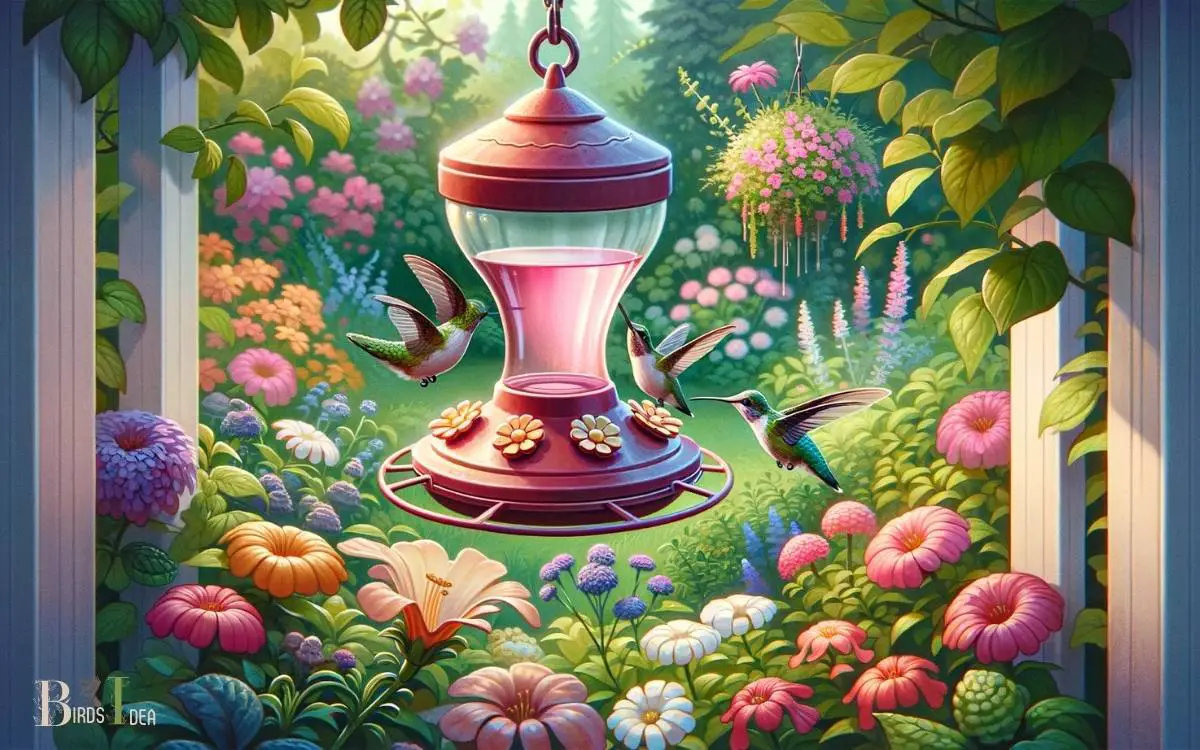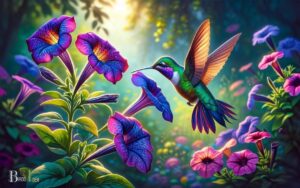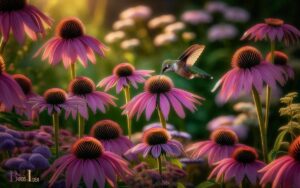Why Is My Hummingbird Feeder Not Attracting Hummingbirds?
To attract hummingbirds to your feeder, ensure it’s in a good location, filled with the right nectar, and maintained properly. Factors such as unclean feeders, incorrect sugar-to-water ratios, and poor placement away from flowers can deter hummingbirds.
Additionally, seasonal migration patterns and local competition from other hummingbirds or feeders can impact their presence.
Attracting hummingbirds involves more than just hanging a feeder.
Consider the following:
Ensuring your hummingbird feeder is an inviting oasis can turn your garden into a hub for these fascinating birds.

Key Takeaway
7 Essential Factors to Attract Hummingbirds to Your Feeder
| Factor | Importance | Tips for Optimization |
|---|---|---|
| Feeder Placement | Essential for visibility and safety | Place in a quiet, sheltered spot away from predators |
| Nectar Quality | Attracts hummingbirds with the right energy source | Use a 4:1 water to sugar ratio; avoid additives |
| Feeder Cleanliness | Prevents disease and keeps feeders attractive to birds | Clean regularly with hot water and a brush |
| Timing | Acknowledges hummingbird migration patterns | Set up feeders during the right season for your region |
| Surrounding Flowers | Provides a natural habitat and additional food sources | Plant native flowers that produce nectar hummingbirds like |
| Competition | May decrease the likelihood of hummingbirds visiting a single feeder | Place multiple feeders to reduce competition |
| Predators | Can deter hummingbirds from visiting | Keep feeders away from places where predators can hide |
Feeder Placement
The key to attracting hummingbirds to your feeder is placing it near flowers or foliage, where the birds can easily spot it. Hummingbirds are naturally attracted to bright, tubular flowers, so hanging your feeder close to these types of plants will increase its visibility.
Additionally, positioning the feeder in a shaded area can help prevent the nectar from spoiling too quickly in the sun. It’s important to ensure that the feeder is easily accessible and not obstructed by any obstacles that could make it difficult for the birds to reach.
By strategically placing the feeder in a location that is both visible and easily accessible, you can significantly increase the chances of attracting hummingbirds to your feeder.
Feeder Maintenance
Keeping a hummingbird feeder clean is crucial for attracting these tiny birds. Mold in the feeder can be harmful to hummingbirds, so it’s important to check for any signs of mold and clean the feeder regularly.
Additionally, replacing old nectar is essential to keep the feeder inviting for hummingbirds.
Clean Feeders Regularly
Regular maintenance is essential for ensuring the effectiveness of hummingbird feeders in attracting birds. One crucial aspect of feeder maintenance is regular cleaning.
Here’s why it’s important:
- Health of Hummingbirds: Clean feeders help prevent the growth of mold and bacteria, which can be harmful to hummingbirds.
- Longevity of Feeders: Regular cleaning can prevent the build-up of grime and extend the lifespan of the feeder, saving money in the long run.
- Attractiveness to Birds: A clean feeder is more likely to attract hummingbirds, as they are drawn to fresh nectar and clean feeding stations.
Check for Mold
To maintain the effectiveness of a hummingbird feeder, it is important to regularly check for mold as part of feeder maintenance.
Mold can develop in the nectar due to the sugar content, warmth, and exposure to sunlight. To prevent mold growth, it’s crucial to clean the feeder with hot water and vinegar every time it’s refilled, even if there’s no visible mold.
Additionally, choosing a feeder with smooth surfaces and wide openings can make it easier to clean and prevent mold buildup. Moldy nectar can be harmful to hummingbirds, so it’s essential to monitor the feeder closely.
By regularly checking for mold and cleaning the feeder appropriately, you can ensure a safe and inviting environment for hummingbirds to visit your feeder.
Replace Old Nectar
After checking for mold and ensuring the feeder is clean, it’s important to regularly replace the old nectar in the feeder to maintain its appeal to hummingbirds. Hummingbirds are attracted to fresh nectar, and leaving old nectar in the feeder can deter them from visiting.
Here’s why it’s crucial to replace the old nectar:
- Nutritional Value: Over time, the nectar loses its nutritional value, and fresh nectar provides the energy hummingbirds need to thrive.
- Prevention of Fermentation: Old nectar can ferment, leading to the growth of harmful bacteria that can make hummingbirds sick.
- Maintaining Freshness: Regularly replacing the nectar ensures that hummingbirds always have access to a fresh and enticing food source.
Choice of Nectar
When it comes to attracting hummingbirds, the choice of nectar is crucial. Hummingbirds have a preference for nectar that is clear and has a similar color to natural flower nectar.
Additionally, the freshness of the nectar plays a significant role in attracting these tiny birds to the feeder.
Nectar Color Preference
Hummingbirds generally prefer nectar that is clear or lightly colored. The color of the nectar can significantly impact their attraction to feeders.
Here’s why:
- Natural Association: Hummingbirds are instinctively drawn to clear nectar, as it closely resembles the natural nectar found in flowers.
- Perceived Freshness: Clear or lightly colored nectar is often perceived as fresher, signaling to hummingbirds that it’s safe for consumption.
- Visibility: Lighter nectar is easier for hummingbirds to see, making it more accessible and appealing to them.
Understanding the preference for clear or lightly colored nectar can help in attracting more hummingbirds to your feeder.
Nectar Freshness Importance
To attract hummingbirds to your feeder, it is essential to prioritize the freshness of the nectar and carefully select the type of nectar used.
Hummingbirds are attracted to fresh, clean nectar, and they may avoid feeders with old or spoiled nectar. It is recommended to change the nectar every 3 to 5 days, especially in warmer weather, to prevent fermentation or mold growth.
When selecting nectar, it is important to avoid using honey, brown sugar, or artificial sweeteners as they can be harmful to hummingbirds. Instead, opt for a simple homemade nectar solution made of white granulated sugar and water.
The table below summarizes the key points to consider when choosing and maintaining the nectar for your hummingbird feeder.
| Consideration | Importance |
|---|---|
| Freshness | Essential |
| Type of Nectar | White sugar and water |
| Change Frequency | Every 3-5 days |
Presence of Predators
The presence of potential predators near a hummingbird feeder can deter hummingbirds from visiting. Hummingbirds are small and vulnerable creatures, so the threat of predators can make them cautious about approaching a feeder.
Here are a few potential predators that could be affecting hummingbird visits:
- House Cats: These common household pets are natural hunters and may stalk or pounce on hummingbirds near the feeder, making the birds feel unsafe.
- Birds of Prey: Larger birds such as hawks or owls can pose a threat to hummingbirds, causing them to avoid areas where these predators are present.
- Insects: Predatory insects like spiders or praying mantises can lurk near feeders and catch hummingbirds, creating a dangerous environment for the tiny birds.
To attract more hummingbirds, it’s important to create a safe and secure environment around the feeder to minimize the presence of potential predators.
Surrounding Environment
Frequently, hummingbirds are drawn to feeders located in areas with abundant natural nectar sources, such as flowering plants and trees.
If your feeder is not attracting hummingbirds, it could be due to the lack of suitable natural nectar sources in the surrounding environment.
Hummingbirds rely on these natural sources for their primary food, and if they are plentiful, it can make your feeder more appealing to them. Consider planting hummingbird-friendly flowers and shrubs in your yard to create a more inviting environment.
Additionally, the presence of trees and shrubs can provide perching and nesting spots for hummingbirds, making your yard a more attractive habitat for them.
By enhancing the surrounding environment with natural nectar sources and suitable perching spots, you can increase the likelihood of attracting hummingbirds to your feeder.
Competition From Other Food Sources
In addition to the surrounding environment, competition from other food sources can also impact the attractiveness of your hummingbird feeder.
Hummingbirds are highly energetic and require a lot of nectar to sustain their rapid metabolism. If there are abundant natural nectar sources in the area, they may not be inclined to visit your feeder.
Additionally, other feeding stations, such as flowering plants, fruit trees, or other types of bird feeders, can draw the attention of hummingbirds away from your feeder.
Moreover, if there are a lot of insects present, hummingbirds may prefer to feed on those instead of the nectar in the feeder. It’s important to consider these competing food sources when trying to attract hummingbirds to your feeder.
Conclusion
Well, if the hummingbirds aren’t flocking to your feeder, maybe it’s time to accept that they just don’t like you. Maybe they’ve heard about your terrible nectar recipe or your lackluster feeder placement.
Or perhaps they’ve found a better, more attractive feeder in the neighborhood. It’s a tough pill to swallow, but maybe it’s time to face the fact that even hummingbirds have standards.






